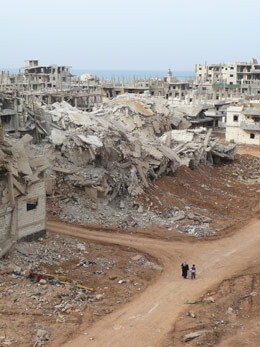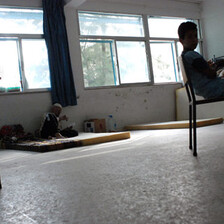Electronic Lebanon 13 February 2008

UNRWA estimates that up to 85 percent of Nahr al-Bared’s homes have been destroyed or rendered uninhabitable. (Lucy Fielder/IRIN)
Prime Minister Fouad Siniora said losses from the battle were great on all levels. “As we release the preliminary plan, we look to the Arab and international communities to meet us with the necessary assurances and funding to ensure its success,” he told reporters at a news conference in Beirut.
The plan focuses on the “old camp” — the original square kilometer of camp which comes under the jurisdiction of the UN Palestinian refugee agency, UNRWA, and was pulverized during the fighting.
At least 169 soldiers, 287 insurgents and 47 civilians were killed in the battle between the army and Islamic militant group Fatah al-Islam in 2007. The fighting also ruined infrastructure and forced the camp’s 40,000 residents to flee, most of them to a neighboring camp. Destruction of Nahr al-Bared’s “new camp” area, which is outside UNRWA jurisdiction, was also severe, though less total.
Siniora said 1,500 families had now returned to the new camp.
The fighting broke out on 20 May 2007 when the police raided a suspected hideout linked to the group, and Fatah al-Islam fighters overran an army checkpoint in bloody retaliation.
UNRWA Commissioner-General Karen AbuZayd told the news conference the rebuilding of Nahr al-Bared would be the largest project ever undertaken by the agency and that the master plan was an important tool to rally international funding.
Aim to rebuild camp by 2010
Although the plan has yet to be finalized and released, a summary presented at the conference said rebuilding should be completed by August 2010 and put the cost at US $173 million. It aims to preserve the social fabric of the old camp by retaining its original areas, which are named after the Palestinians’ villages of origin, now in northern Israel.
AbuZayd said it could be months before rebuilding started. The army needs to finish removing unexploded ordnance from the old camp, although some refugee families are being allowed back for the first time into de-mined areas of the old camp to retrieve any documents or valuables they can from beneath the rubble. Next comes the rubble-removal stage, which could last for months.
“We will not only reconstruct the old camp, but also make it a better environment in which our architectural plans ensure that people have access to daylight no matter where they live; there will be ventilation where there was no ventilation before; and we will create open spaces for the benefit of the population, especially the children, while also keeping in mind the legitimate security concerns of the Lebanese army and government,” AbuZayd said.
Siniora said the Nahr al-Bared crisis presented an opportunity for the state to extend its authority over the camp.
Security in Lebanon’s 12 official refugee camps, home to just over half the country’s 400,000 Palestinians, has been left to Palestinian factions since the Cairo Agreement of 1969, with the army forbidden from crossing camp boundaries.
Nahr al-Bared’s Lebanese neighbors will also be compensated for any losses owing to the 16 weeks of fighting, and helped to rebuild, Siniora said, adding that the state had begun mapping their needs with UN agencies and international donors. This would help to restore harmony between Palestinian and Lebanese residents of the area, enabling more refugees to return to their houses.
This item comes to you via IRIN, a UN humanitarian news and information service, but may not necessarily reflect the views of the United Nations or its agencies. All IRIN material may be reposted or reprinted free-of-charge; refer to the copyright page for conditions of use. IRIN is a project of the UN Office for the Coordination of Humanitarian Affairs.
Related Links


